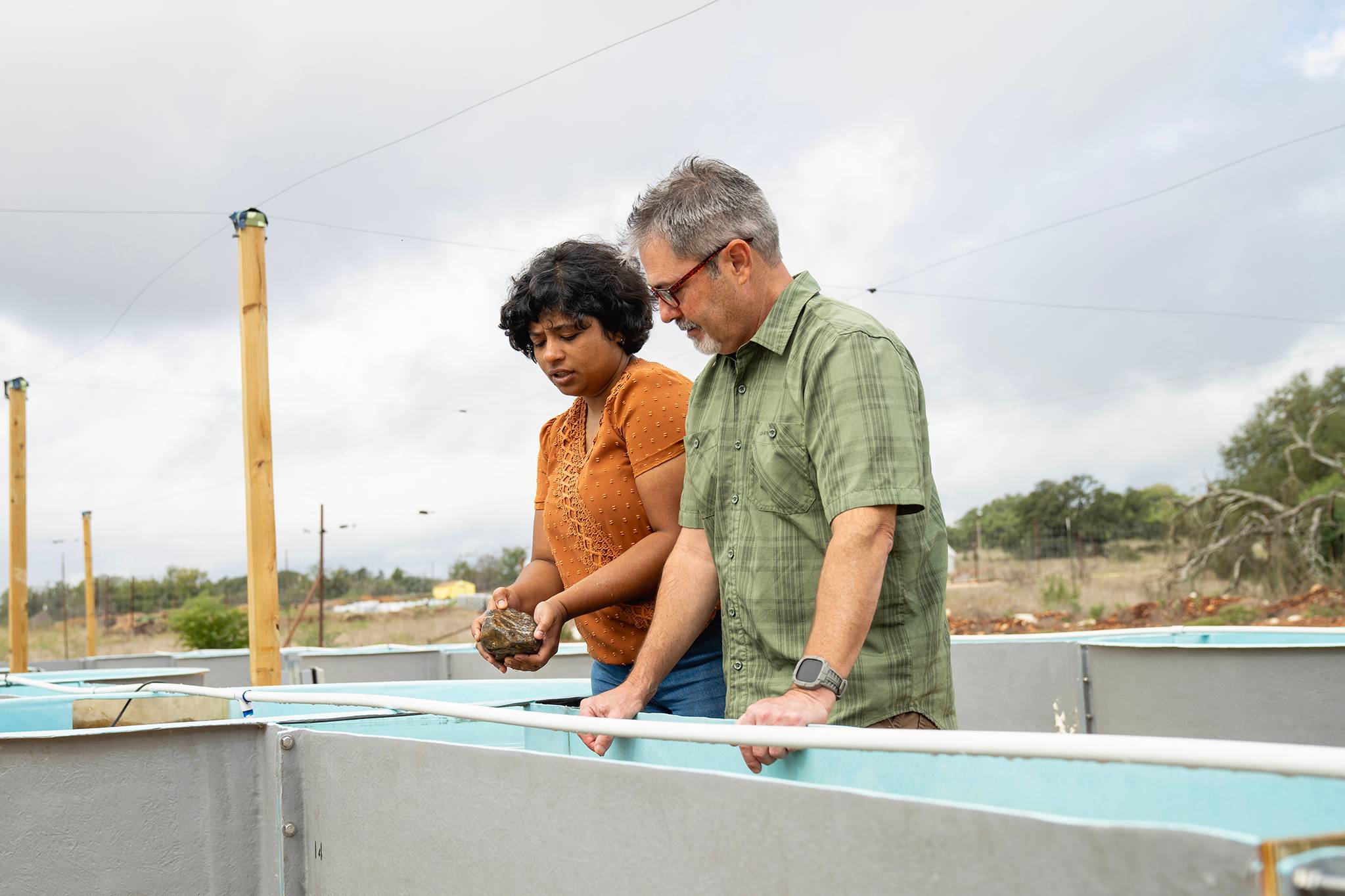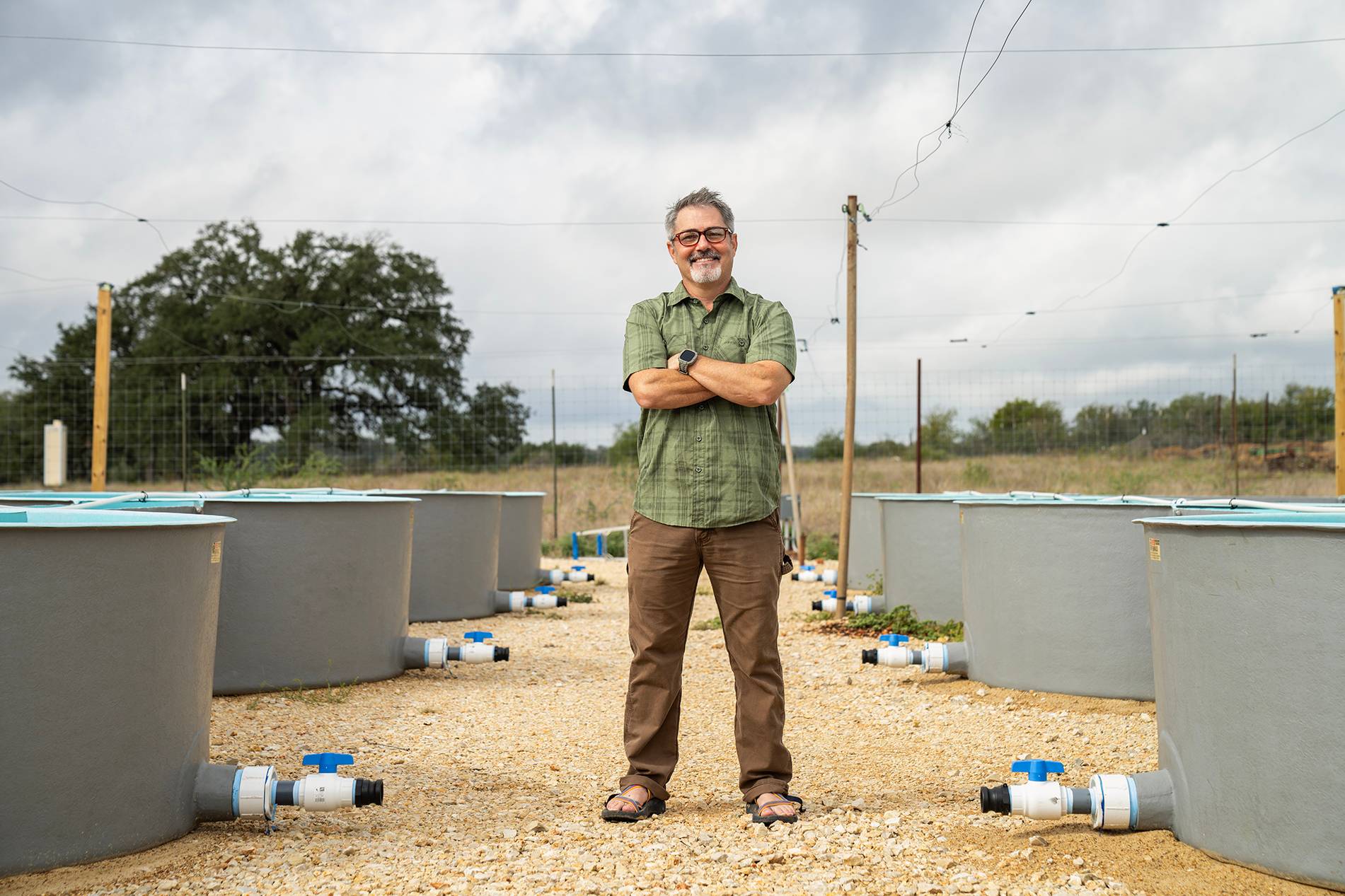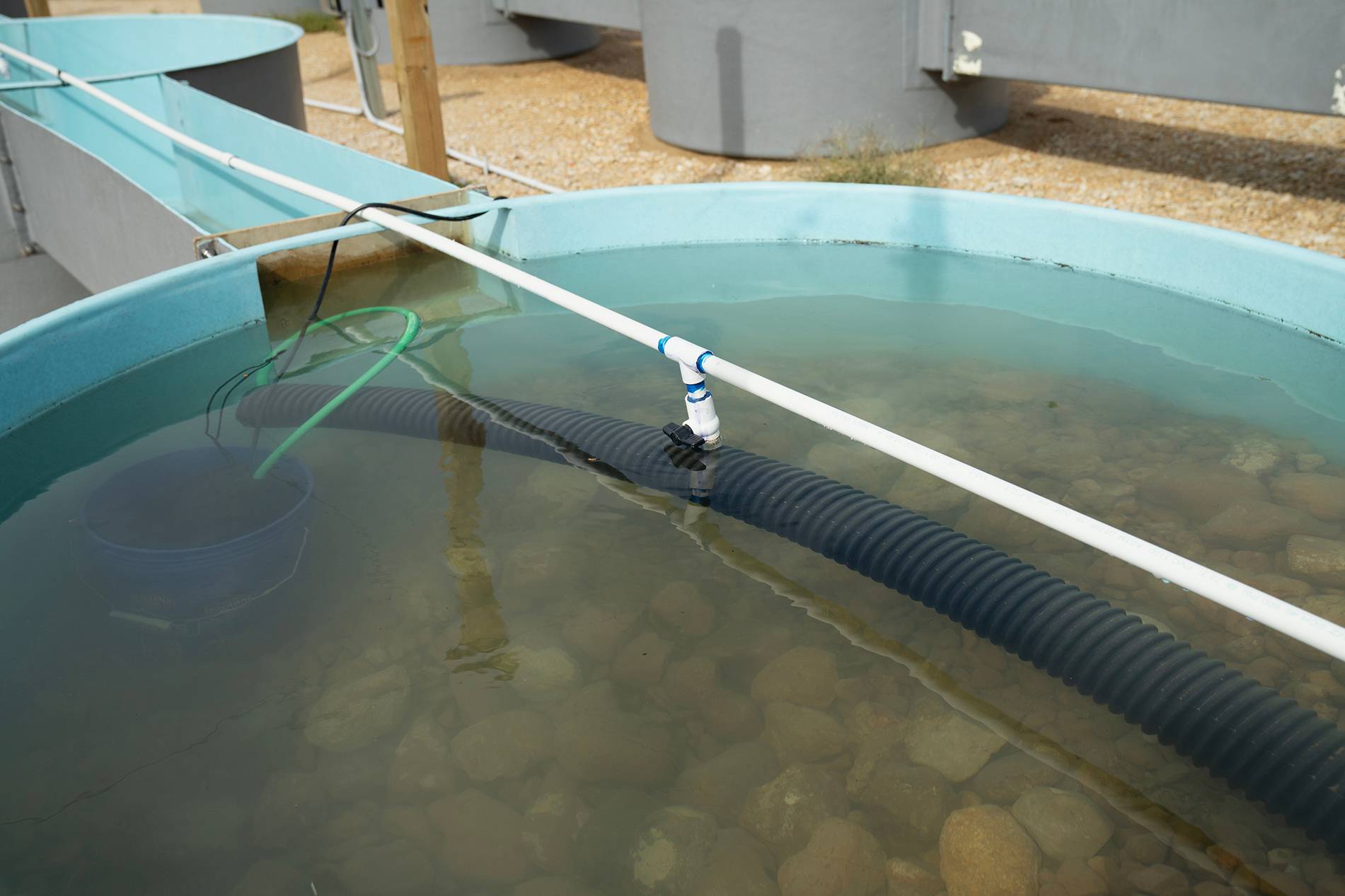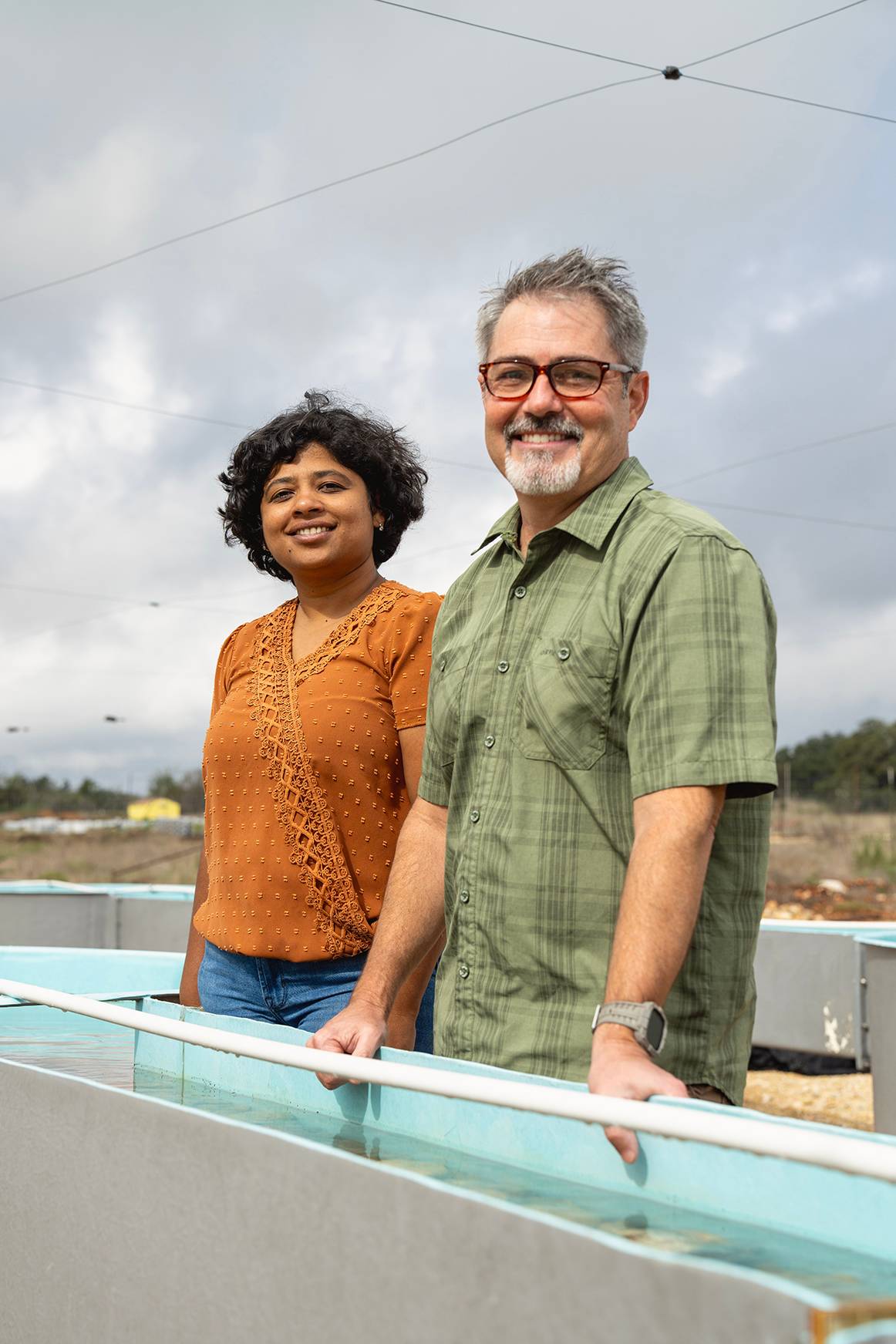Texas State teams with the Army Corps of Engineers on a $15 million Texas river research project
By Matt Joyce

Rivers are naturally messy. Fish, mussels, dragonflies, and their freshwater friends live in an unpredictable world, one that’s growing more extreme as the climate warms.
To better understand how factors such as drought and flooding affect freshwater species, Texas State University’s Department of Biology recently built an experimental stream facility at the Freeman Center, a TXST ranch just west of San Marcos. The outdoor lab — which looks like a collection of 24 hot tubs connected by chutes — replicates the pools and riffles of natural streams. But unlike in the wild, researchers can control the conditions in these streams to create order amid the natural mess.
“When we’re researching in the field, we’re trying to make sense out of the chaos,” says Mariana Perez Rocha, a postdoctoral fellow who’s conducting a pilot study on macroinvertebrates using the new outdoor lab. “With this experimental facility, we can control the flow, the water level, the drift. We can dry everything and then fill it with water again.”


Weston Nowlin, a TXST aquatic ecologist, designed the $120,000 facility. It’s part of Texas State’s larger collaborative project with the Army Corps of Engineers called “Quantifying drivers of native and non-native aquatic species abundance and distribution in drought- and flood-prone Texas basins.”
The TXST-Corps of Engineers partnership — known as a Cooperative Ecosystem Study Unit — launched in 2021 with $7.5 million in funding from the corps. This September, the U.S. Army Engineer Research and Development Center renewed the program for another three-year span with an additional $7.5 million in funding.
As part of the partnership, faculty, postdoctoral, and student researchers from TXST and other universities have formed the Texas Research Institute for Aquatic and Groundwater Ecology, or TRIAGE. The researchers are fanning out across Texas to assess the health, populations, and movement of freshwater organisms like mussels, insects, fish, and bacteria — as well as riverbank material like tree leaves — to see how they respond to changing stream conditions. They’ve gathered data from hundreds of sites on the Colorado, Concho, San Saba, Llano, Pedernales, Guadalupe, San Marcos, Comal, Neches, Red, and Rio Grande rivers.
The river data will contribute to the Corps of Engineers’ “next generation ecological modeling,” says Todd Swannack, a senior research biologist with the U.S. Army Engineer Research and Development Center.
The Corps of Engineers manages the nation’s navigable waterways, and Swannack says these new models will help the corps anticipate the ramifications of climate change and make decisions for projects like building and managing dams, channels, and reservoirs.

“The idea is to predict what’s going to happen, what we call risk-informed decision making,” says Swannack, who offices at TXST as the corps’ liaison. “By developing refined quantitative tools for accurate predictions, the Corps of Engineers has more precision for understanding what’s going to happen in the future so they can design and plan better to keep up with future issues like climate change and rising sea levels.”
Nowlin, the principal investigator for the first phase of the partnership, says Texas is a fitting location for the project because of the state’s diversity of river ecosystems. East Texas rivers like the Neches are comparable to those in the southeastern U.S.; West Texas’ desert conditions are relatable to the western U.S.; and the Red River of North Texas reflects Great Plains and prairie ecosystems.
“We’re exploring patterns that we see in Texas and then extrapolating that out across the U.S.,” Nowlin says. “Texas has this central location, and so we have a diversity of biome types and diversity of river system types. We can leverage those big gradients and use those for research.”
Swannack says the Corps of Engineers selected TXST as a partner for the project because of the faculty's expertise and the regional environment. Central Texas, for example, is at the nexus of water-resource issues including urbanization, endangered species, water scarcity, and navigation.
“The cool thing with Texas State is the professors here are world-renowned at getting field data on the species and doing it at multiple scales,” Swannack says. “For the Corps of Engineers to develop strategies that are sustainable in the future, we must understand how the environment is related to those waterways, whether it’s in the water or the habitats surrounding the water. And Texas has a gradient of river types — the climate, temperature, landscapes. It is pretty representative of what you see across the country.”
Astrid Schwalb, a stream ecologist in the biology department, is the principal investigator for the second phase of the Corps of Engineers partnership. Her lab is surveying mussel populations at river sites across Texas. Mussels are among the most imperiled animals in North America, she notes.
Schwalb and her team will return to sites multiple times to see how the mussel populations have changed over time through conditions such as the summer of 2023 drought.

Drying streams are hard on mussels because mussels can’t swim to deeper waters. Rather, they rely on fish to distribute their larvae, Schwalb explains. After females release the larvae, the larvae attach to fish and stay on them for weeks or months before detaching and settling into the substrate to grow into adults.
“Whatever happens to the fish is important for the mussels,” she says. “But usually as one research group, you can’t be expert in everything. That’s why collaborations are so impactful. We are hoping to gather a data set over decades, because some of the mussels get to be 30 or 40 years old. To really understand what’s going on, you need a long-term data set.”
Texas’ extreme weather conditions can make it difficult to gather such information in the field, whether for temporary field experiments or long-term monitoring. For example, equipment can get damaged or swept away during a flood.
“This just happens in the natural river,” Schwalb says. “But with [the experimental stream facility], you can really have control: OK, we’re going to do seven days of drying, and then control the rains, the substrate, and the flow.”
Nowlin says the researchers have only begun to analyze the data they’ve collected in the field for the Corps of Engineers project. Some of the early results shed light on which species, such as fish and insects, can adapt to inconsistent river flows; and those that tend to get wiped out when a stream dries, such as mussels.
The new experimental stream facility will help researchers fill in gaps that may be difficult to resolve in the field. “To have the ability to get this kind of funding and build a facility like this is something that doesn’t come along very often,” Nowlin says. “We’re one of a select few universities to be set up to do these really nice experimental manipulations.” ★